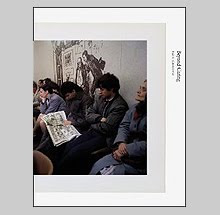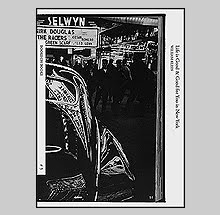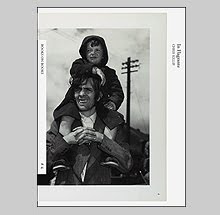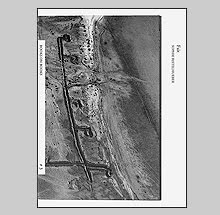Defining Moments in American Photography series from UC Press
The 20 hour flight from
Now usually I do not care for books dedicated solely to history so on first glance I thought these would be prime candidates as simple dust collectors, sitting on my shelf neglected and mostly unread. But…these are not simply history lessons; they provoke thought and examine the work in the realm of other visual culture. The series goal is to “investigate key photographers and images in the history of American photography. Reshape that history with attention to race, gender, and class; bring focused and accessible studies of American photography to a wide audience; place American photography at the center of American visual culture; and bring into dialogue writers from art history, American studies, cultural studies, gender studies, literary studies, and American history.” (Whew!)
Each book contains two essays by different authors and each tackle a different aspect of the work. For instance, in On Alexander Gardner’s Photographic Sketchbook, Anthony W. Lee writes at length about the history behind the creation of the Sketchbook and also the role photography played in relation to war and to other means of documentation such as the sketch artists who were also working the battlefields. Then, Elizabeth Young takes the conversation in a different direction with her essay, Verbal Battlefields, which examines the relation of words to photographs since
Even the more straight forward history has interesting details that were new to me (although I should say that I am hardly a scholar of
I also did not know that, like Roger Fenton in the Crimean War,
Both of the essays by Lee and Young are written in styles that are fully comprehendible, entertaining and approach sophisticated readings of the work while avoiding stifling and bloated language. The size, layout and design are very well done but if I had one criticism, it would be that there are not enough illustrations. Over the course of 80 text pages there are only 28 illustrations and less than half of those are actual reproductions from the Sketchbook. The ‘rebel sharpshooter’ photograph, for instance, is not reproduced anywhere in the book even though it is offered as a prime example of Gardner‘s fabrications.
The series is being released in both hard and soft cover editions. The hardcover edition will retail for $50.00 which seems very expensive for the size and length but thankfully the soft cover retails for a very reasonable $19.95, making it affordable for students and teachers who will benefit greatly from this series.
(My own life crossed interestingly with a bit of photographic history from the Civil War in that a friend just moved out of a huge 4800 square foot loft in 359 Broadway. 359 Broadway was the building that Mathew Brady, the other great civil war photographer, had a portrait gallery and photo studio back in the 1850‘s. Brady had set up the gallery on the second floor and was said to experiment with lighting his subjects with skylights on the top floor. My friend lived on the top floor and the skylight mentioned is so large that it extends the ceiling of that room upwards of twenty feet. He did rent the space out as a photo studio but mostly we took advantage of the high ceiling in that skylight room to string a net across the gap and partake in marathon tournaments of drunken badminton. Interesting to think that 150 years ago Brady was photographing dignitaries and the social elite in the same room in which we were now arguing about whether the shuttlecock landed in or out of bounds on our makeshift court.)
Even though I mentioned that I found Defining Moments in American Photography #2, Lynching Photographs, an odd choice of subject for so early into a series, it does serve as an interesting companion to the first book on Gardner‘s Sketchbook. Both discuss dark, brutal periods in American history and both examine race as portrayed in photographs.
As with the Twin Palms book, Without Sanctuary: Lynching Photographs in
Most lynchings were spectacles. Due to the victims mostly being of African descent, they were meant as confirmations of supposed social/racial hierarchy for whites and also as warning to blacks that the law cannot protect them from harm should they test that hierarchy. The role of photography as witness becomes a complicated dance between documentation and drawing the viewer of the photograph into the spectacle of the lynch mob. Looking at these photographs, we peer at what has taken place just as the surrounding mob is doing the same.
The series editor Anthony W. Lee expresses this point in his introduction when he writes about the Roth Horowitz gallery’s exhibit of lynching photographs from the collection of James Allen in 2000. Due to the popularity of the exhibit and small size of the gallery, the viewers were forced to huddle together, jostling for space while looking at the small photographs pinned to the walls and arranged in vitrine cases. Lee’s observation was that the “viewers are left with an exhibit that is too close to the spectacle created by the lynchers themselves.”
The first essay by Shawn Michelle Smith called the Evidence of Lynching Photographs concentrates on what we see in these photographs and how certain images have been appropriated by different groups to serve different causes. The most famous image by Lawrence Beitler of the 1930 lynching of Thomas Shipp and Abram Smith in
The fact that many of the photographs were offered for sale or produced as postcards by the photographers amplifies their existence as perverse celebrations of lawlessness and racist vigilantism. Smith pulls a fascinating observation from one example of a postcard sent by a young man to his parents. In the margins of the postcard which depicts a burnt corpse he has written, “This is a barbecue we had last night. My picture is to the left with a cross over it. Your sone [sic] Joe.” With this caption and his marking an ‘x’ over where he appears in the crowd it can be presumed that he imagines that his parents will be proud of his participation in the killing of an African American. Thus the bond between son and parent as well as their shared race will be strengthened by the murder. As Smith writes: “In this postcard, the death of a black man enables whiteness to be shared.”
The second essay by Dora Apel entitled Lynching Photographs and the Politics of Public Shaming asks the questions: Why take photographs of atrocity and body horror? Who has the right to look at such photos? Is looking a voyeuristic indulgence, a triumphal act, or an experience in shame?
Towards the end of her essay, Apel writes of how, at least on one occasion, a lynching photograph actually contributed to a change in the course of history. The infamous killing of Emmett Till for whistling at a white woman in
Again, as editor of the series, Alexander W. Lee is choosing writers for their clarity and thoughtfulness. The ease at which these books read and provoke thought is a pleasure that I hope will continue to be a characteristic throughout the entire series. With these two books setting the pace, I am looking forward to other releases with great anticipation.
University of California Press
Book Available Here (On Alexander Gardner's Sketchbook)
Book Available Here (Lynching Photographs)













